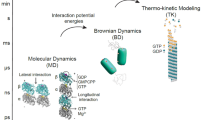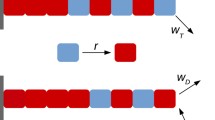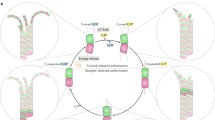Abstract
In order to quantify the intrinsic dynamics associated with the tip of a GTP-cap under semi-confined conditions, such as those within a neuronal cone and at a kinetochore–microtubule interface, we propose a novel quantitative concept of critical nano local GTP-tubulin concentration (CNLC). A simulation of a rate constant of GTP-tubulin hydrolysis, under varying conditions based on this concept, generates results in the range of 0-420 s−1. These results are in agreement with published experimental data, validating our model. The major outcome of this model is the prediction of 11 random and distinct outbursts of GTP hydrolysis per single layer of a GTP-cap. GTP hydrolysis is accompanied by an energy release and the formation of discrete expanding zones, built by less-stable, skewed GDP-tubulin subunits. We suggest that the front of these expanding zones within the walls of the microtubule represent soliton-like movements of local deformation triggered by energy released from an outburst of hydrolysis. We propose that these solitons might be helpful in addressing a long-standing question relating to the mechanism underlying how GTP-tubulin hydrolysis controls dynamic instability. This result strongly supports the prediction that large conformational movements in tubulin subunits, termed dynamic transitions, occur as a result of the conversion of chemical energy that is triggered by GTP hydrolysis (Satarić et al., Electromagn Biol Med 24:255–264, 2005). Although simple, the concept of CNLC enables the formulation of a rationale to explain the intrinsic nature of the “push-and-pull” mechanism associated with a kinetochore–microtubule complex. In addition, the capacity of the microtubule wall to produce and mediate localized spatio-temporal excitations, i.e., soliton-like bursts of energy coupled with an abundance of microtubules in dendritic spines supports the hypothesis that microtubule dynamics may underlie neural information processing including neurocomputation (Hameroff, J Biol Phys 36:71–93, 2010; Hameroff, Cognit Sci 31:1035–1045, 2007; Hameroff and Watt, J Theor Biol 98:549–561, 1982).






Similar content being viewed by others
References
Janulevicius, A., van Pelt, J., van Ooyen, A.: Compartment volume influences microtubule dynamic instability: a model study. Biophys. J. 90, 788–798 (2006)
Rezania, V., Tuszynski, J.A.: A stochastic model for microtubule dynamicity involving mixtures of tubulin isotypes. Int. J. Quantum Chem. 109, 3430–3440 (2009)
Rieder, C.L., Salmon, E.D.: The vertebrate cell kinetochore and its roles during mitosis. Trends Cell Biol. 8, 310–318 (1998)
Mitchison, T., Kirschner, M.: Dynamic instability of microtubule growth. Nature 312, 237–242 (1984)
O’Brien, E.T., Voter, W.A., Erickson, H.P.: GTP hydrolysis during microtubule assembly. Biochemistry 26, 4148–4156 (1987)
Erickson, H.P., O’Brien, E.T.: Microtubule dynamic instability and GTP hydrolysis. Annu. Rev. Biophys. Biomol. Struct. 21, 145–166 (1992)
Needleman, D.J., Groen, A., Ohi, R., Maresca, T., Mirny, L., Mitchison, T.: Fast microtubule dynamics in meiotic spindles measured by single molecule imaging: evidence that the spindle environment does not stabilize microtubules. Mol. Biol. Cell. 21, 323–333 (2010)
Schek, H.T., III, Hunt, A.J.: Microtubules: mechanical meets chemical. Biophys. J. 89, 2909–2910 (2005)
Kamath, K., Oroudjev, E., Jordan, M.A.: Determination of microtubule dynamic instability in living cells. Methods Cell. Biol. 97, 1–14 (2010)
Kapitein, L.C., Yau, K.W., Hoogenraad, C.C.: Microtubule dynamics in dendritic spines. Methods Cell. Biol. 97, 111–132 (2010)
Kitamura, E., Tanaka, K., Kitamura, Y., Tanaka, T.U.: Kinetochore microtubule interaction during S phase in Saccharomyces cerevisiae. Genes Dev. 21, 3319–3330 (2007)
Suzuki, A., Hori, T., Nishino, T., Usukura, J., Miyagi, A., Morikawa, K., Fukagawa, T.: Spindle microtubules generate tension-dependent changes in the distribution of inner kinetochore proteins. J. Cell Biol. 193, 125–140 (2011)
Tolic-Norrelykke, I.M.: Push-me-pull-you: how microtubules organize the cell interior. Eur. Biophys. J. 37, 1271–1278 (2008)
DeLuca, J.G.: Kinetochore–microtubule dynamics and attachment stability. Methods Cell Biol. 97, 53–79 (2010)
Tabony, J.: Microtubules viewed as molecular ant colonies. Biol. Cell 98, 603–617 (2006)
Duesberg, P.: Chromosomal chaos and cancer. Sci. Am. 296, 52–59 (2007)
McEwen, B.F., Arena, J.T., Frank, J., Rieder, C.L.: Structure of the colcemid-treated PtK1 kinetochore outer plate as determined by high-voltage electron microscopic tomography. J. Cell Biol. 120, 301–312 (1993)
Cleveland, D.W., Mao, Y., Sullivan, K.F.: Centromeres and kinetochores: from epigenetics to mitotic checkpoint signaling. Cell 112, 407–421 (2003)
Maddox, P., Straight, A., Coughlin, P., Mitchison, T.J., Salmon, E.D.: Direct observation of microtubule dynamics at kinetochores in Xenopus extract spindles: implications for spindle mechanics. J. Cell Biol. 162, 377–382 (2003)
Kirschner, M., Mitchison, T.: Beyond self-assembly: from microtubules to morphogenesis. Cell 45, 329–342 (1986)
Cheeseman, I.M., Desai, A.: Molecular architecture of the kinetochore–microtubule interface. Nat. Rev. Mol. Cell Biol. 9, 33–46 (2008)
Maiato, H., DeLuca, J., Salmon, E.D., Earnshaw, W.C.: The dynamic kinetochore–microtubule interface. J. Cell Sci. 117, 5461–5477 (2004)
Clarke, P.R.: Cell biology. A gradient signal orchestrates the mitotic spindle. Science 309, 1334–1335 (2005)
Fuller, B.G.: Self-organization of intracellular gradients during mitosis. Cell Div. 5, 5 (2010)
Dong, Y., Vanden Beldt, K.J., Meng, X., Khodjakov, A., McEwen, B.F.: The outer plate in vertebrate kinetochores is a flexible network with multiple microtubule interactions. Nat. Cell Biol. 9, 516–522 (2007)
Oosawa, F., Asakura, S.: Thermodynamics of the Polymerization of Protein. Academic Press, London (1975)
Bergen, L.G., Borisy, G.G.: Head-to-tail polymerization of microtubules in vitro. Electron microscope analysis of seeded assembly. J. Cell Biol. 84, 141–150 (1980)
Pantaloni, D., Carlier, M.F.: Involvement of guanosine triphosphate (GTP) hydrolysis in the mechanism of tubulin polymerization: regulation of microtubule dynamics at steady state by a GTP cap. Ann. New York Acad. Sci. 466, 496–509 (1986)
Coue, M., Lombillo, V.A., McIntosh, J.R.: Microtubule depolymerization promotes particle and chromosome movement in vitro. J. Cell Biol. 112, 1165–1175 (1991)
Howard, J., Hyman, A.A.: Dynamics and mechanics of the microtubule plus end. Nature 422, 753–758 (2003)
Mitchison, T.J., Kirschner, M.W.: Properties of the kinetochore in vitro. I. Microtubule nucleation and tubulin binding. J. Cell Biol. 101, 755–765 (1985)
Mitchison, T., Kirschner, M.: Microtubule assembly nucleated by isolated centrosomes. Nature 312, 232–237 (1984)
Summers, K., Kirschner, M.W.: Characteristics of the polar assembly and disassembly of microtubules observed in vitro by darkfield light microscopy. J. Cell Biol. 83, 205–217 (1979)
Burns, R.G.: Kinetics of GTP hydrolysis during the assembly of chick brain MAP2-tubulin microtubule protein. Biochem. J. 277(Pt 1), 239–243 (1991)
Carlier, M.F., Pantaloni, D.: Kinetic analysis of guanosine 5′-triphosphate hydrolysis associated with tubulin polymerization. Biochemistry 20, 1918–1924 (1981)
Vandecandelaere, A., Brune, M., Webb, M.R., Martin, S.R., Bayley, P.M.: Phosphate release during microtubule assembly: what stabilizes growing microtubules? Biochemistry 38, 8179–8188 (1999)
Rezania, V., Tuszynski, J.A.: A stochastic model for microtubule dynamicity involving mixtures of tubulin isotopes. Int. J. Quantum Chem. 109, 3430–3440 (2009)
Frohlich, H.: Modern Biochemistry. Plenum Press, New York (1996)
Trpisova, B., Tuszynski, J.A.: Possible link between guanosine 5′ triphosphate hydrolysis and solitary waves in microtubules. Phys. Rev. E 55, 3288–3305 (1997)
Satarić, M.V., Tuszynski, J.A., Zakula, R.B.: Kink-like excitations as an energy-transfer mechanism in microtubules. Phys. Rev. E 48, 589–597 (1993)
Satarić, M.V., Zakula, R.B., and Tuszynski, J.A.: A model of the energy transfer mechanisms in microtubules involving a single soliton. Nanobiology 1, 445–456 (1992)
Satarić, M.V., Satarić, B.M., Tuszynski, J.A.: Nonlinear model of microtubule dynamics. Electromagn. Biol. Med. 24, 255–264 (2005)
Gardiner, J., Overall, R., Marc, J.: The microtubule cytoskeleton acts as a key downstream effector of neurotransmitter signaling. Synapse 65, 249–256 (2011)
Sekulic, D.L., Satarić, B.M., Tuszynski, J.A., Satarić, M.V.: Nonlinear ionic pulses along microtubules. Eur. Phys. J. E Soft Matter 34, 1–11 (2011)
Craddock, T.J., Tuszynski, J.A., Priel, A., Freedman, H.: Microtubule ionic conduction and its implications for higher cognitive functions. J. Integr. Neurosci. 9, 103–122 (2010)
Lizier, J.T., Prokopenko, M., Zomaya, A.Y.: Local information transfer as a spatiotemporal filter for complex systems. Phys. Rev. E 77, 026110 (2008)
Tirosh, R.: Ballistic protons and microwave-induced water solitons in bioenergetic transformations. Int. J. Molec. Sci. 7, 320–345 (2006)
Pokorny, J., Jelinek, F., Trkal, V., Lamprecht, I., Holzel, R.: Vibrations in microtubules. Astrophys. Space Sci. 23, 171–179 (1997)
Chou, K.C., Zhang, C.T., Maggiora, G.M.: Solitary wave dynamics as a mechanism for explaining the internal motion during microtubule growth. Biopolymers 34, 143–153 (1994)
Davydov, A.S.: Solitons and energy transfer along protein molecules. J. Theor. Biol. 66, 379–387 (1977)
Hameroff, S.: The “conscious pilot”-dendritic synchrony moves through the brain to mediate consciousness. J. Biol. Phys. 36, 71–93 (2010)
Hameroff, S.R.: The brain is both neurocomputer and quantum computer. Cognit. Sci. 31, 1035–1045 (2007)
Hameroff, S.R., Watt, R.C.: Information processing in microtubules. J. Theor. Biol. 98, 549–561 (1982)
Pantaloni, D., Carlier, M.F., Korn, E.D.: The interaction between ATP-actin and ADP-actin. A tentative model for actin polymerization. J. Biol. Chem. 260, 6572–6578 (1985)
Walker, R.A., O’Brien, E.T., Pryer, N.K., Soboeiro, M.F., Voter, W.A., Erickson, H.P., Salmon, E.D.: Dynamic instability of individual microtubules analyzed by video light microscopy: rate constants and transition frequencies. J. Cell Biol. 107, 1437–1448 (1988)
Voter, W.A., O’Brien, E.T., Erickson, H.P.: Dilution-induced disassembly of microtubules: relation to dynamic instability and the GTP cap. Cell Motil. Cytoskelet. 18, 55–62 (1991)
Schek, H.T., III, Gardner, M.K., Cheng, J., Odde, D.J., Hunt, A.J.: Microtubule assembly dynamics at the nanoscale. Curr. Biol. 17, 1445–1455 (2007)
Acknowledgements
We express our sincere gratitude to Professor Maxwell Bennett, AO (Professor of Neuroscience, University Chair and Scientific Director, Brain and Mind Research Institute, The University of Sydney) for continued support.
Author information
Authors and Affiliations
Corresponding author
Rights and permissions
About this article
Cite this article
Buljan, V.A., Holsinger, R.M.D., Hambly, B.D. et al. Intrinsic microtubule GTP-cap dynamics in semi-confined systems: kinetochore–microtubule interface. J Biol Phys 39, 81–98 (2013). https://doi.org/10.1007/s10867-012-9287-3
Received:
Accepted:
Published:
Issue Date:
DOI: https://doi.org/10.1007/s10867-012-9287-3




